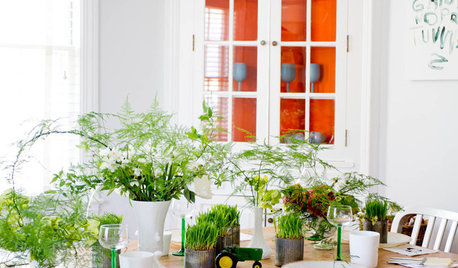Asparagus really worth it?!
lexie1397
11 years ago
Related Stories

COOL-SEASON CROPSCool-Season Vegetables: How to Grow Asparagus
Patience pays off with this harbinger of spring that lasts for decades in the garden
Full Story
FOLIAGEGreat Design Plant: Foxtail Fern
Not actually a fern, this vivid member of the asparagus family has a distinctive appearance to awaken a garden year-round
Full Story
COMMUNITYArt, Edibles and Community Make Magic in a Pittsburgh Garden
With a name like Friendship, is it any wonder this neighborhood created such an enchanting community garden?
Full Story
GARDENING GUIDES11 Favorite Edibles for Your Cool-Season Garden
Plant crunchy carrots, crisp radishes, tender peas and other vegetables for fall and spring harvests
Full Story
GARDENING AND LANDSCAPINGSpring Patio Fix-Ups: 12 Wonderful Ways With Planters
Change the look of your whole patio with just a few thoughtfully placed containers or a trellis brimming with greenery
Full Story
PLANTING IDEASBig Foliage for Small Spaces
Use bold, large-leaved plants to create intriguing contrast in a garden where they’re least expected
Full Story
12 Vegetable Peelers to Make Quick Work of Your Garden Bounty
Steel yourself: These ergonomic and modern-looking tools bear little resemblance to the one-note peelers of the past
Full Story
DECORATING PROJECTSFashion a Greens-Laden Tablescape for Spring
Pair lush greenery and flowers with milk glass for an arrangement that will make any meal memorable
Full Story
KIDS’ SPACESColor and Pattern Play in a Happy New Nursery
A spontaneous mix of pear green, patterns, antiques and modern pieces makes for a cheerful, love-filled room for a baby girl
Full Story
PRODUCT PICKSGuest Picks: Dreaming of a White Christmas
20 snowy white decorations to give the holidays a chic, modern look
Full StoryMore Discussions







ltilton
veggiecanner
Related Professionals
Folsom Landscape Architects & Landscape Designers · Fort Lee Landscape Architects & Landscape Designers · Zion Landscape Architects & Landscape Designers · Farmington Landscape Contractors · Hicksville Landscape Contractors · Natick Landscape Contractors · Rosemount Landscape Contractors · Soddy Daisy Landscape Contractors · West Covina Landscape Contractors · Winchester Landscape Contractors · Cheshire Gardeners & Lawn Care · Grand Rapids Driveway Installation & Maintenance · Grayslake Driveway Installation & Maintenance · Leesburg Driveway Installation & Maintenance · South Lyon Driveway Installation & Maintenanceglib
tishtoshnm Zone 6/NM
edweather USDA 9a, HZ 9, Sunset 28
lexie1397Original Author
steve_in_los_osos
chickenfreak
sweetquietplace
ltilton
sunnibel7 Md 7
glib
naturegirl_2007 5B SW Michigan
macky77
tishtoshnm Zone 6/NM
albert_135 39.17°N 119.76°W 4695ft.
HU-469456
lexie1397Original Author
katie49
lexie1397Original Author
lexie1397Original Author
wally_1936
sunnibel7 Md 7
soilent_green
lexie1397Original Author